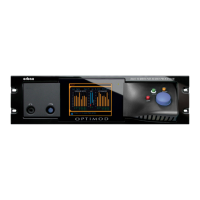2-6
INSTALLATION ORBAN MODEL 8685
Analog Outputs are mainly provided for monitoring various audio signals through
XLR-type connectors. However, because of low tilt and overshoot they can also drive
transmitters while maintaining tight peak control.
Word clock/AES11id Sync Input is provided on a female BNC connector.
Optional HD-SDI Input and Output supporting SD-SDI (per SMPTE 259M); 1.5
Gbit/s HD-SDI (per SMPTE 292M; up to 720p and 1080i) and 3.0 Gbit/s single-wire
HD-SDI (per SMPTE 424M; 1080p) are provided on two female BNC connectors. See
Optional HD-SDI Input/Output Interface Module on page 6-3.
V
ideo Sync Input supporting SMPTE 274M and SMPTE 296M is provided on a
female BNC connector on the optional HD-SDI module.
Input and Output Connections
AES3id Digital Inputs and Outputs
The base unit has five AES3id audio inputs and six AES3id audio outputs, while the
optional HD-SDI module instead has three AES3id inputs and three AES3id outputs.
The inputs and outputs are all equipped with sample rate converters and can oper-
ate at 32, 44.1, 48, 88.2, and 96 kHz. You can force the output sample rate to be
genlocked to signal appearing at either the word clock/AES11id sync input or the
audio input. The output can also synchronize to the 8685’s internal clock.
Inputs and outputs follow the AES3id standard. This specifies 75Ω unbal-
anced coaxial cable, terminated in male BNC connectors. It is suitable for
very long cable runs (up to 1000 meters).
If you wish to connect these inputs and outputs to an AES3 balanced
connection, it is wise to insert a 110Ω/75Ω balun transformer between
the AES3 and AES3id sides of the connection to ensure best signal integ-
rity.
The digital input clip level is fixed at 0 dB relative to the maximum digital
word. The maximum digital input will make the 8685 input meters dis-
play 0dB. The reference level is adjustable using the DI
REF control.
The 8685’s internal sample rate is 48 kHz. Because of “asynchronous re-
sampling,” any output sample rate other than 48 kHz/internal sync can
introduce overshoots.
If you need to use an STL with 32 kHz sample rate (because that is all that
is available), you will achieve lowest overshoot by setting the 8685’s in-
ternal bandwidth to 15 kHz. That way, the 8685’s peak limiter operates
on a signal with 15 kHz bandwidth and subsequent sample rate conver-
sion will not add overshoot caused by spectral truncation.
For a discussion of sync issues, see Sample Frequency Synchronization on
page 1-14.

